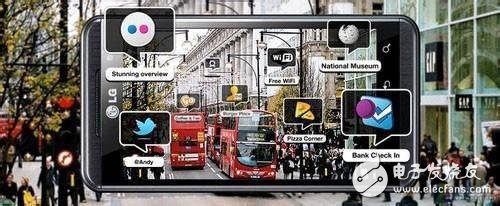It is undeniable that the current true AR hardware cost is very high, and the smartphone AR experience provided to users is still at a very crude level.
Various forms of AR hardware
Handheld devices
The representative of handheld devices is a smartphone that naturally contains the various elements required for AR: gyroscopes, gps, cameras, and powerful processors. However, smartphones still have significant limitations in terms of interaction.

Fixed AR equipment
It’s a thing of the past to take off your clothes and try on new clothes in the store, thanks to a high-tech innovation. A Russian company invented a virtual fitting mirror. When the shopper stood in front of the screen, the virtual fitting mirror would show the three-dimensional image after the try-on. You can change the style of the garment without moving it. You can change the clothes simply by rotating the buttons on the screen.

The fixed AR system is suitable for scenes that require a larger display or higher resolution in a fixed location. Unlike mobile AR devices, these less mobile systems can be equipped with more advanced camera systems, so they can more accurately identify people and scenes.
Head mounted display (HMD)
HMD represents another rapidly growing AR hardware type. The HMD consists of a headgear (such as a helmet) and one or more (micro) displays that are paired with it. The HMD overlays the images of the real world and virtual objects in the user's field of view. In other words, the user does not directly see the reality, seeing the actual enhanced video picture.

Space Augmented Reality System (SAR)
The virtual content of the Spatial Augmented Reality (SAR) system is directly projected in the real world. SAR systems are often fixed in nature. Any physical surface, such as walls, tables, foam, wooden blocks, or even the human body, can be an interactive display. As projection equipment size, cost, power consumption, and 3D projection continue to advance, new forms of interaction and display are emerging.
Smart glasses
Smart glasses are actually an integrated device with glasses, screens, cameras and microphones. According to this concept, the user's real-world perspective is intercepted by the AR device, and the enhanced screen is redisplayed in the user's field of view. The AR image enters the eyeball through the spectacle lens or through the spectacle lens. The most prominent examples of smart eyewear technology are Google Glass and the Vuzix M100.

AR product system structure

Virtual model output real world
AR hardware key technology
1. Object detection and recognition
The purpose of object detection and recognition is to find and find targets in the scene. In the field of augmented reality, common detection and recognition tasks include face detection, pedestrian detection, vehicle detection, gesture recognition, biometric recognition, emotion recognition, and natural scene recognition.
Technical Difficulties: Lack of sufficient data to reach the mature stage of deep learning.
2, augmented reality display technology
The video perspective helmet display acquires an image of the external real environment through a miniature camera mounted on the helmet, that is, the camera captures the image of the real scene for transmission.
The basic principle of the optical principle of the perspective helmet display is to present the real scene and the virtual scene through the fusion of a pair of semi-reverse half lenses installed in front of the eyes.
This display mode of not using the screen as a carrier completes the display of the virtual object by recording and reproducing the light field. By presenting images of different depths, the user can achieve active focusing when viewing close-range or distant scenes, which is also a major advantage of light field display.
Technical difficulties: each program has its own advantages and disadvantages, and the light field technology is worth looking forward to.
An original equipment manufacturer (OEM) is a company that produces parts and equipment that may be marketed by another manufacturer. ... Other-brand parts would be considered aftermarket, such as Champion spark plugs, DieHard batteries, Kinsler fuel injectors, and ... Electronics manufacturing services (EMS); Open-design movement · Open-source hardware · Original design ...
Lightings: Headlamp, Emergency Light, Sloar Flashlight, Search Light, Lanten,Bicycle Light, LED light, Military Flashlight, High-end Flashlight, High Power Flashlight, Bright Flashlight,Solar Street Lights,Miner Lamp etc...
Back-up Power: Robots(Educational Robot,Rescue Robot,Service Robot etc...),Wheelchairs,UPS,Electric Mopping Machine,Vehicle Intelligent Terminal, Fishing Equipment etc...
Medical Devices: Portable EGC monitor,Breathing Machine,Portable Oxygen Making Machine etc...
Portable Devices: GPS,PDA,E-Book, PMP, PSP, Laptop, Walkie-Talkies etc-
Others: Electric Toys, RC Models, Model Aircraft, Mobile Power Supply, Hand Electric Drill, etc-
Odm 48V Solar Batteries,Odm Rechargeable Battery,Odm Lifepo4 Lithium Battery,Odm Lithium Battery
Shenzhen Glida Electronics Co., Ltd. , https://www.szglida.com